目录
[习题6-1P 推导RNN反向传播算法BPTT.](#习题6-1P 推导RNN反向传播算法BPTT.)
[习题6-2 推导公式(6.40)和公式(6.41)中的梯度.](#习题6-2 推导公式(6.40)和公式(6.41)中的梯度.)
[习题6-3 当使用公式(6.50)作为循环神经网络的状态更新公式时, 分析其可能存在梯度爆炸的原因并给出解决方法.](#习题6-3 当使用公式(6.50)作为循环神经网络的状态更新公式时, 分析其可能存在梯度爆炸的原因并给出解决方法.)
[习题6-2P 设计简单RNN模型,分别用Numpy、Pytorch实现反向传播算子,并代入数值测试.](#习题6-2P 设计简单RNN模型,分别用Numpy、Pytorch实现反向传播算子,并代入数值测试.)
习题6-1P 推导RNN反向传播算法BPTT.
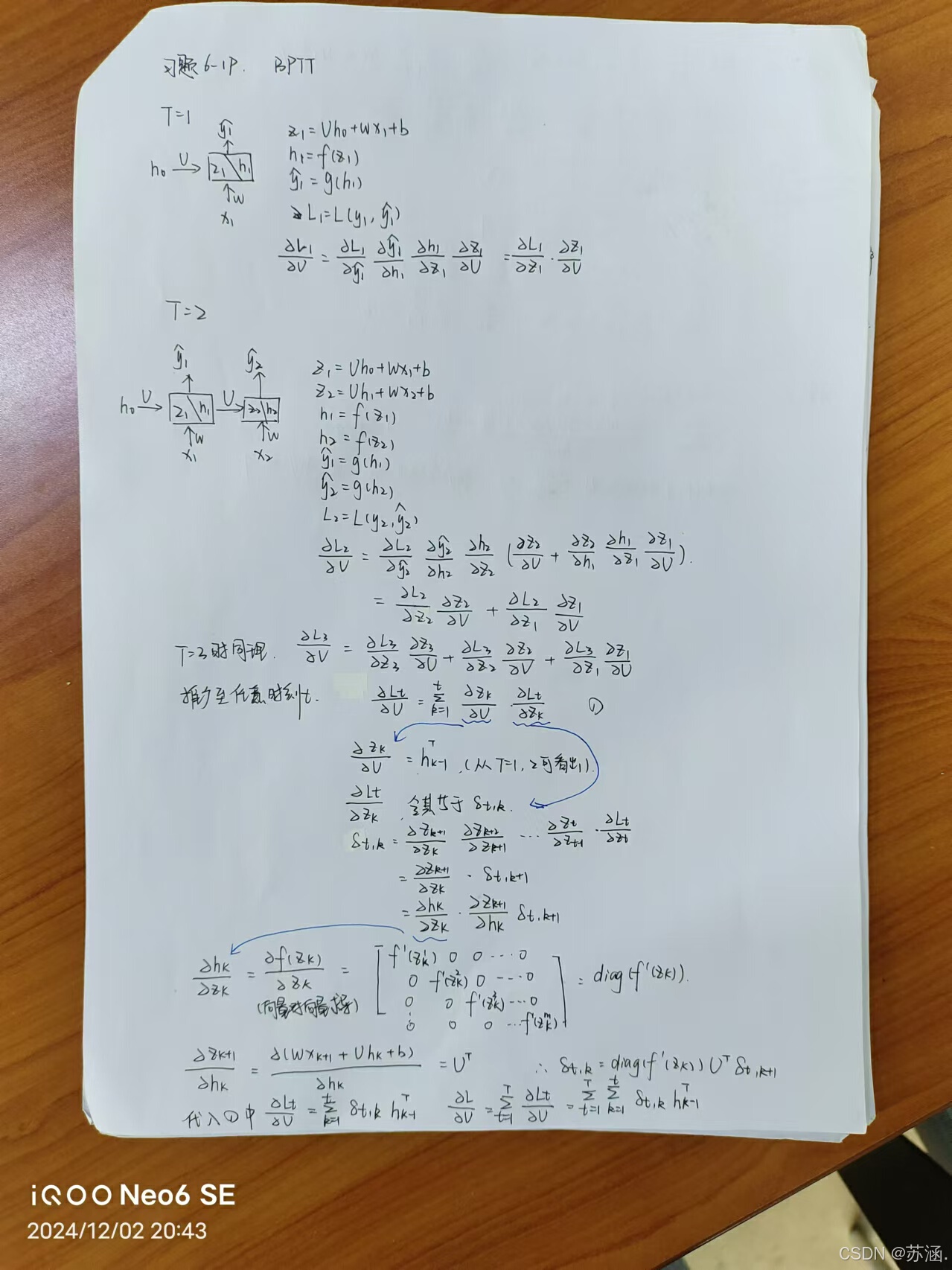
习题6-2 推导公式(6.40)和公式(6.41)中的梯度.
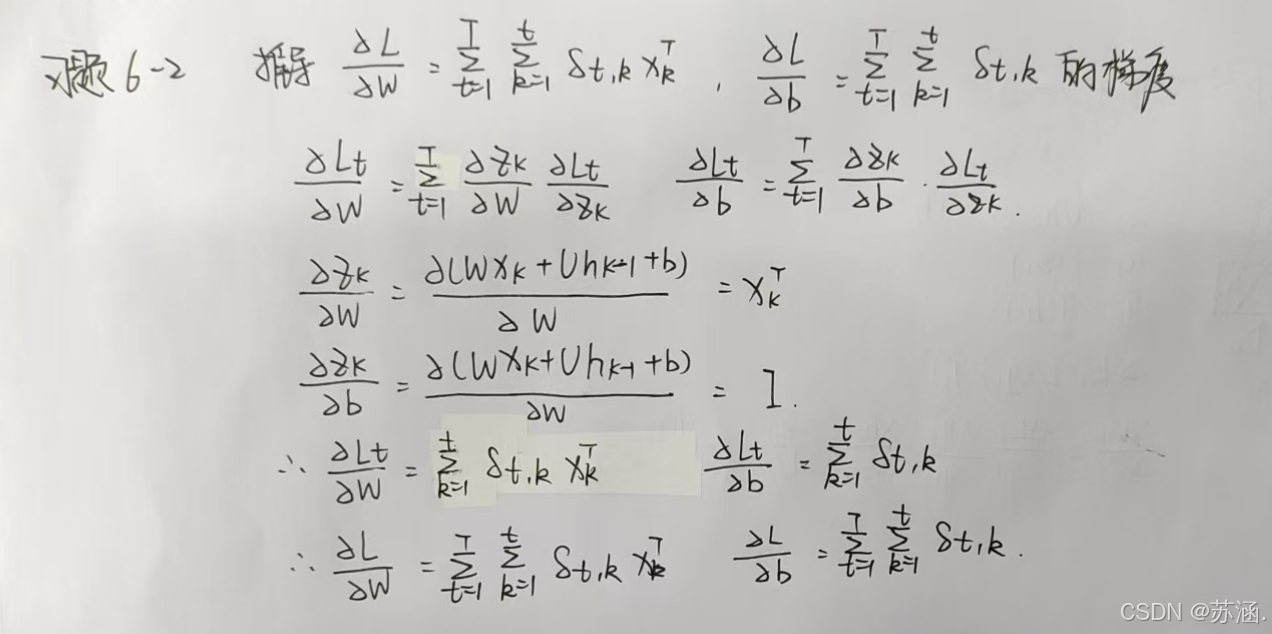
习题6-3 当使用公式(6.50)作为循环神经网络的状态更新公式时, 分析其可能存在梯度爆炸的原因并给出解决方法.

解决方法:
可以通过引入门控机制来进一步改进模型,主要有:长短期记忆网络(LSTM)和门控循环单元网络(GRU)。
LSTM:
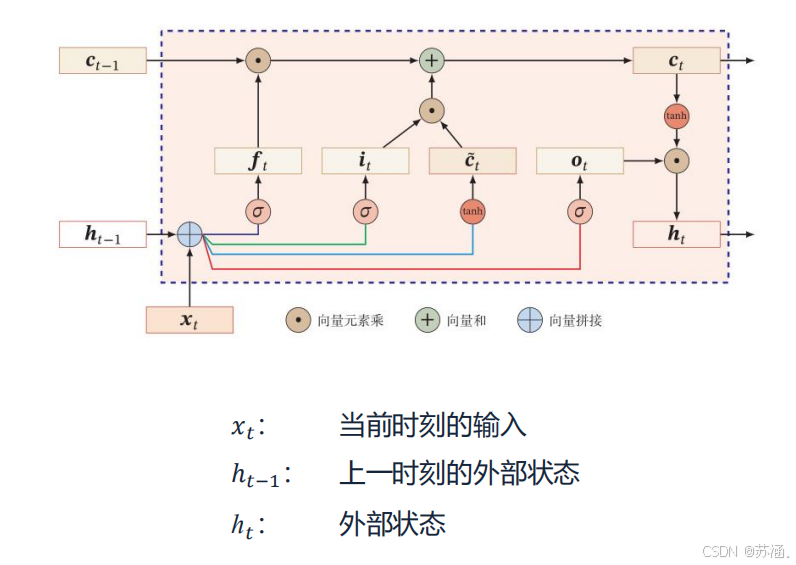
LSTM 通过引入多个门控机制(输入门、遗忘门和输出门)以及一个独立的细胞状态(Cell State),来实现对信息的选择性记忆和遗忘,从而捕捉长序列的依赖关系。
关键组件:


优点
- 能够捕捉长期依赖关系。
- 对梯度消失问题有较好的抑制效果。
缺点
- 结构复杂,参数较多,训练时间长。
- 在某些任务中可能存在过拟合问题。
GRU:
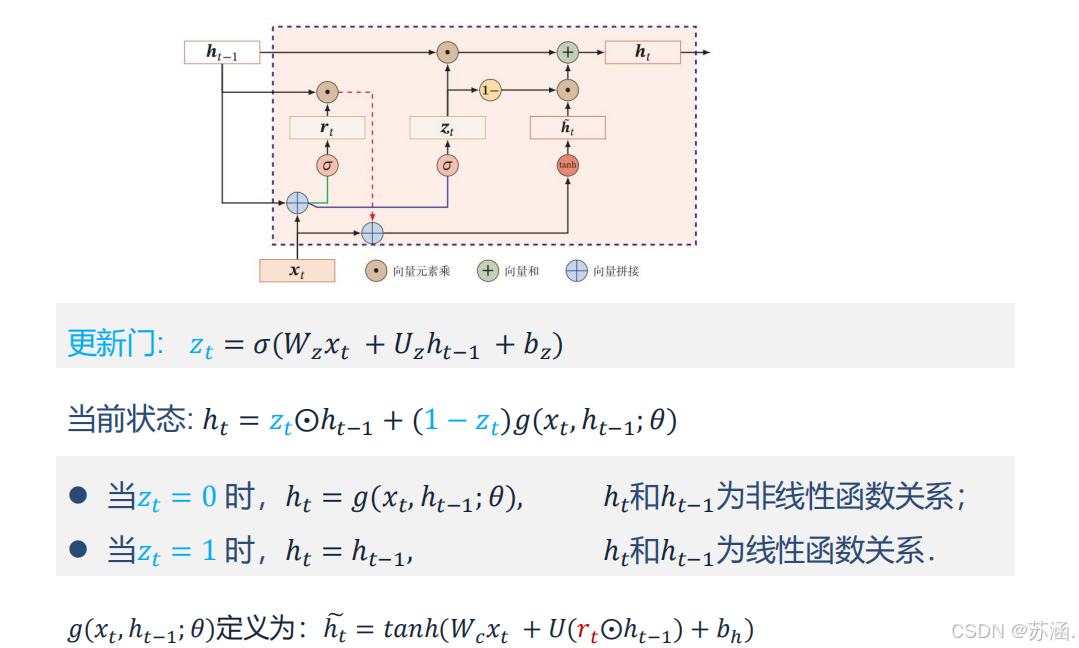
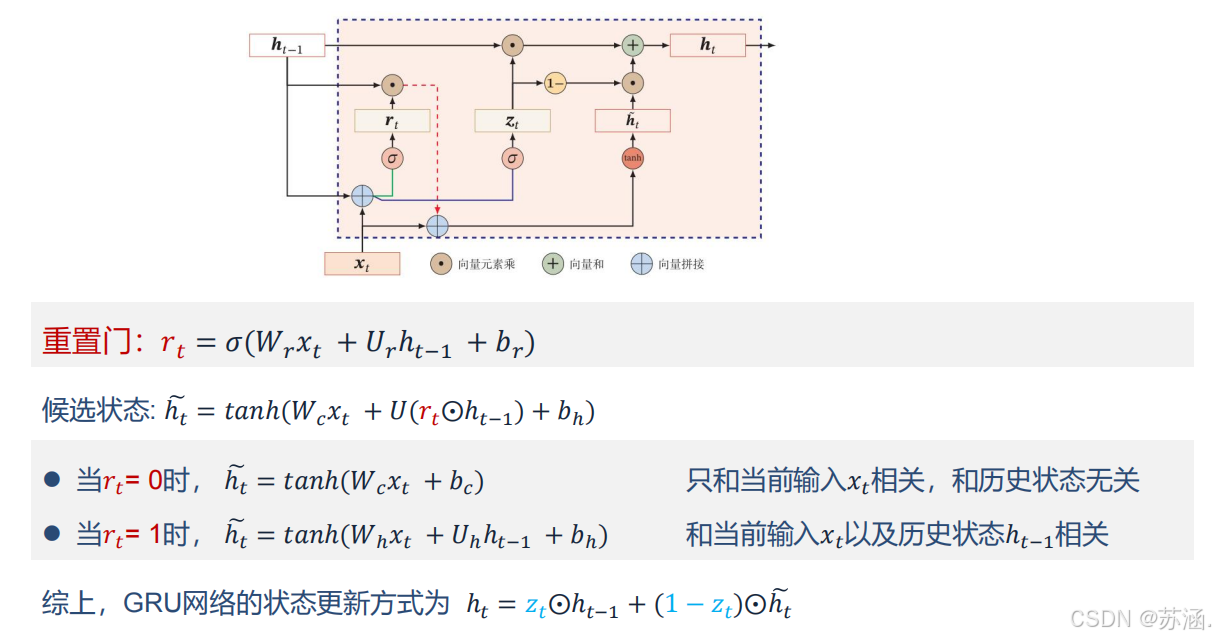
GRU 是 LSTM 的简化版本,融合了遗忘门和输入门,减少了网络的复杂性,同时保持了对长序列依赖关系的建模能力。
优点
- 参数比 LSTM 更少,计算效率更高。
- 能在某些任务中达到与 LSTM 类似的性能。
缺点
- 不具备 LSTM 的完全灵活性,在极长序列任务中可能表现略逊色。
习题6-2P 设计简单RNN模型,分别用Numpy、Pytorch实现反向传播算子,并代入数值测试.
(1)RNNCell前向传播
代码如下:
# ======RNNcell前向传播==================================================================
def rnn_cell_forward(xt, a_prev, parameters):
# Retrieve parameters from "parameters"
Wax = parameters["Wax"]
Waa = parameters["Waa"]
Wya = parameters["Wya"]
ba = parameters["ba"]
by = parameters["by"]
### START CODE HERE ### (≈2 lines)
# compute next activation state using the formula given above
a_next = np.tanh(np.dot(Wax, xt) + np.dot(Waa, a_prev) + ba)
# compute output of the current cell using the formula given above
yt_pred = F.softmax(torch.from_numpy(np.dot(Wya, a_next) + by), dim=0)
### END CODE HERE ###
# store values you need for backward propagation in cache
cache = (a_next, a_prev, xt, parameters)
return a_next, yt_pred, cache
np.random.seed(1)
xt = np.random.randn(3, 10)
a_prev = np.random.randn(5, 10)
Waa = np.random.randn(5, 5)
Wax = np.random.randn(5, 3)
Wya = np.random.randn(2, 5)
ba = np.random.randn(5, 1)
by = np.random.randn(2, 1)
parameters = {"Waa": Waa, "Wax": Wax, "Wya": Wya, "ba": ba, "by": by}
a_next, yt_pred, cache = rnn_cell_forward(xt, a_prev, parameters)
print("a_next[4] = ", a_next[4])
print("a_next.shape = ", a_next.shape)
print("yt_pred[1] =", yt_pred[1])
print("yt_pred.shape = ", yt_pred.shape)
print("===================================================================")运行结果:

(2)RNNcell反向传播
代码如下:
python
# ======RNNcell反向传播========================================================
def rnn_cell_backward(da_next, cache):
# Retrieve values from cache
(a_next, a_prev, xt, parameters) = cache
# Retrieve values from parameters
Wax = parameters["Wax"]
Waa = parameters["Waa"]
Wya = parameters["Wya"]
ba = parameters["ba"]
by = parameters["by"]
### START CODE HERE ###
# compute the gradient of tanh with respect to a_next (≈1 line)
dtanh = (1 - a_next * a_next) * da_next # 注意这里是 element_wise ,即 * da_next,dtanh 可以只看做一个中间结果的表示方式
# compute the gradient of the loss with respect to Wax (≈2 lines)
dxt = np.dot(Wax.T, dtanh)
dWax = np.dot(dtanh, xt.T)
# 根据公式1、2, dxt = da_next .( Wax.T . (1- tanh(a_next)**2) ) = da_next .( Wax.T . dtanh * (1/d_a_next) )= Wax.T . dtanh
# 根据公式1、3, dWax = da_next .( (1- tanh(a_next)**2) . xt.T) = da_next .( dtanh * (1/d_a_next) . xt.T )= dtanh . xt.T
# 上面的 . 表示 np.dot
# compute the gradient with respect to Waa (≈2 lines)
da_prev = np.dot(Waa.T, dtanh)
dWaa = np.dot(dtanh, a_prev.T)
# compute the gradient with respect to b (≈1 line)
dba = np.sum(dtanh, keepdims=True, axis=-1) # axis=0 列方向上操作 axis=1 行方向上操作 keepdims=True 矩阵的二维特性
### END CODE HERE ###
# Store the gradients in a python dictionary
gradients = {"dxt": dxt, "da_prev": da_prev, "dWax": dWax, "dWaa": dWaa, "dba": dba}
return gradients
np.random.seed(1)
xt = np.random.randn(3, 10)
a_prev = np.random.randn(5, 10)
Wax = np.random.randn(5, 3)
Waa = np.random.randn(5, 5)
Wya = np.random.randn(2, 5)
b = np.random.randn(5, 1)
by = np.random.randn(2, 1)
parameters = {"Wax": Wax, "Waa": Waa, "Wya": Wya, "ba": ba, "by": by}
a_next, yt, cache = rnn_cell_forward(xt, a_prev, parameters)
da_next = np.random.randn(5, 10)
gradients = rnn_cell_backward(da_next, cache)
print("gradients[\"dxt\"][1][2] =", gradients["dxt"][1][2])
print("gradients[\"dxt\"].shape =", gradients["dxt"].shape)
print("gradients[\"da_prev\"][2][3] =", gradients["da_prev"][2][3])
print("gradients[\"da_prev\"].shape =", gradients["da_prev"].shape)
print("gradients[\"dWax\"][3][1] =", gradients["dWax"][3][1])
print("gradients[\"dWax\"].shape =", gradients["dWax"].shape)
print("gradients[\"dWaa\"][1][2] =", gradients["dWaa"][1][2])
print("gradients[\"dWaa\"].shape =", gradients["dWaa"].shape)
print("gradients[\"dba\"][4] =", gradients["dba"][4])
print("gradients[\"dba\"].shape =", gradients["dba"].shape)
gradients["dxt"][1][2] = -0.4605641030588796
gradients["dxt"].shape = (3, 10)
gradients["da_prev"][2][3] = 0.08429686538067724
gradients["da_prev"].shape = (5, 10)
gradients["dWax"][3][1] = 0.39308187392193034
gradients["dWax"].shape = (5, 3)
gradients["dWaa"][1][2] = -0.28483955786960663
gradients["dWaa"].shape = (5, 5)
gradients["dba"][4] = [0.80517166]
gradients["dba"].shape = (5, 1)
print("================================================================")运行结果:
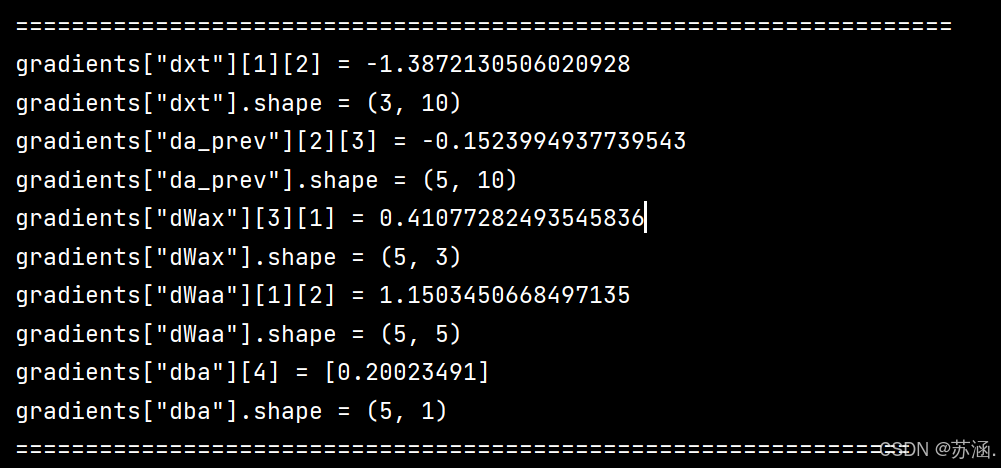
(3)RNN前向传播
代码如下:
python
# ====RNN前向传播==============================================================
def rnn_forward(x, a0, parameters):
# Initialize "caches" which will contain the list of all caches
caches = []
# Retrieve dimensions from shapes of x and Wy
n_x, m, T_x = x.shape
n_y, n_a = parameters["Wya"].shape
### START CODE HERE ###
# initialize "a" and "y" with zeros (≈2 lines)
a = np.zeros((n_a, m, T_x))
y_pred = np.zeros((n_y, m, T_x))
# Initialize a_next (≈1 line)
a_next = a0
# loop over all time-steps
for t in range(T_x):
# Update next hidden state, compute the prediction, get the cache (≈1 line)
a_next, yt_pred, cache = rnn_cell_forward(x[:, :, t], a_next, parameters)
# Save the value of the new "next" hidden state in a (≈1 line)
a[:, :, t] = a_next
# Save the value of the prediction in y (≈1 line)
y_pred[:, :, t] = yt_pred
# Append "cache" to "caches" (≈1 line)
caches.append(cache)
### END CODE HERE ###
# store values needed for backward propagation in cache
caches = (caches, x)
return a, y_pred, caches
np.random.seed(1)
x = np.random.randn(3, 10, 4)
a0 = np.random.randn(5, 10)
Waa = np.random.randn(5, 5)
Wax = np.random.randn(5, 3)
Wya = np.random.randn(2, 5)
ba = np.random.randn(5, 1)
by = np.random.randn(2, 1)
parameters = {"Waa": Waa, "Wax": Wax, "Wya": Wya, "ba": ba, "by": by}
a, y_pred, caches = rnn_forward(x, a0, parameters)
print("a[4][1] = ", a[4][1])
print("a.shape = ", a.shape)
print("y_pred[1][3] =", y_pred[1][3])
print("y_pred.shape = ", y_pred.shape)
print("caches[1][1][3] =", caches[1][1][3])
print("len(caches) = ", len(caches))
print("=============================================================")运行结果:

(4)RNN反向传播
代码如下:
python
# =====RNN反向传播=================================================================
def rnn_backward(da, caches):
### START CODE HERE ###
# Retrieve values from the first cache (t=1) of caches (≈2 lines)
(caches, x) = caches
(a1, a0, x1, parameters) = caches[0] # t=1 时的值
# Retrieve dimensions from da's and x1's shapes (≈2 lines)
n_a, m, T_x = da.shape
n_x, m = x1.shape
# initialize the gradients with the right sizes (≈6 lines)
dx = np.zeros((n_x, m, T_x))
dWax = np.zeros((n_a, n_x))
dWaa = np.zeros((n_a, n_a))
dba = np.zeros((n_a, 1))
da0 = np.zeros((n_a, m))
da_prevt = np.zeros((n_a, m))
# Loop through all the time steps
for t in reversed(range(T_x)):
# Compute gradients at time step t. Choose wisely the "da_next" and the "cache" to use in the backward propagation step. (≈1 line)
gradients = rnn_cell_backward(da[:, :, t] + da_prevt, caches[t]) # da[:,:,t] + da_prevt ,每一个时间步后更新梯度
# Retrieve derivatives from gradients (≈ 1 line)
dxt, da_prevt, dWaxt, dWaat, dbat = gradients["dxt"], gradients["da_prev"], gradients["dWax"], gradients[
"dWaa"], gradients["dba"]
# Increment global derivatives w.r.t parameters by adding their derivative at time-step t (≈4 lines)
dx[:, :, t] = dxt
dWax += dWaxt
dWaa += dWaat
dba += dbat
# Set da0 to the gradient of a which has been backpropagated through all time-steps (≈1 line)
da0 = da_prevt
### END CODE HERE ###
# Store the gradients in a python dictionary
gradients = {"dx": dx, "da0": da0, "dWax": dWax, "dWaa": dWaa, "dba": dba}
return gradients
np.random.seed(1)
x = np.random.randn(3, 10, 4)
a0 = np.random.randn(5, 10)
Wax = np.random.randn(5, 3)
Waa = np.random.randn(5, 5)
Wya = np.random.randn(2, 5)
ba = np.random.randn(5, 1)
by = np.random.randn(2, 1)
parameters = {"Wax": Wax, "Waa": Waa, "Wya": Wya, "ba": ba, "by": by}
a, y, caches = rnn_forward(x, a0, parameters)
da = np.random.randn(5, 10, 4)
gradients = rnn_backward(da, caches)
print("gradients[\"dx\"][1][2] =", gradients["dx"][1][2])
print("gradients[\"dx\"].shape =", gradients["dx"].shape)
print("gradients[\"da0\"][2][3] =", gradients["da0"][2][3])
print("gradients[\"da0\"].shape =", gradients["da0"].shape)
print("gradients[\"dWax\"][3][1] =", gradients["dWax"][3][1])
print("gradients[\"dWax\"].shape =", gradients["dWax"].shape)
print("gradients[\"dWaa\"][1][2] =", gradients["dWaa"][1][2])
print("gradients[\"dWaa\"].shape =", gradients["dWaa"].shape)
print("gradients[\"dba\"][4] =", gradients["dba"][4])
print("gradients[\"dba\"].shape =", gradients["dba"].shape)
print("===========================================================")运行结果:
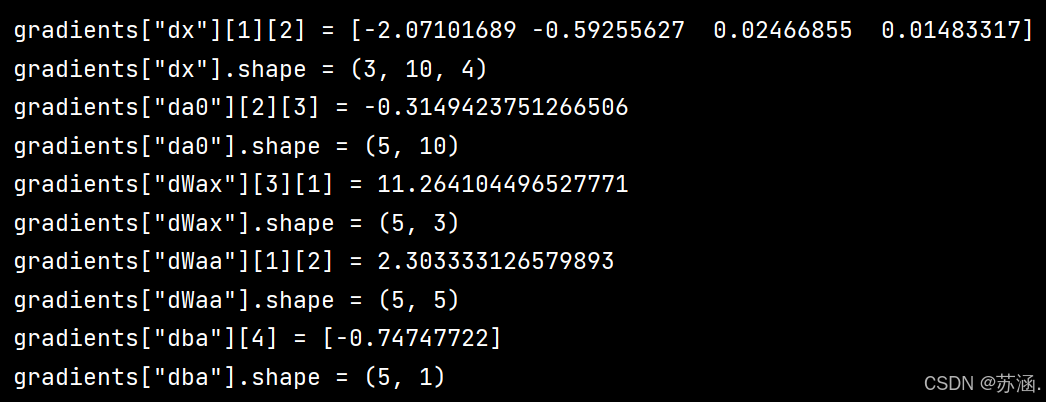
(5)分别用numpy和torch实现前向和反向传播
代码如下:
python
# =====分别用numpy和torch实现前向和反向传播===================================================
import torch
import numpy as np
class RNNCell:
def __init__(self, weight_ih, weight_hh,
bias_ih, bias_hh):
self.weight_ih = weight_ih
self.weight_hh = weight_hh
self.bias_ih = bias_ih
self.bias_hh = bias_hh
self.x_stack = []
self.dx_list = []
self.dw_ih_stack = []
self.dw_hh_stack = []
self.db_ih_stack = []
self.db_hh_stack = []
self.prev_hidden_stack = []
self.next_hidden_stack = []
# temporary cache
self.prev_dh = None
def __call__(self, x, prev_hidden):
self.x_stack.append(x)
next_h = np.tanh(
np.dot(x, self.weight_ih.T)
+ np.dot(prev_hidden, self.weight_hh.T)
+ self.bias_ih + self.bias_hh)
self.prev_hidden_stack.append(prev_hidden)
self.next_hidden_stack.append(next_h)
# clean cache
self.prev_dh = np.zeros(next_h.shape)
return next_h
def backward(self, dh):
x = self.x_stack.pop()
prev_hidden = self.prev_hidden_stack.pop()
next_hidden = self.next_hidden_stack.pop()
d_tanh = (dh + self.prev_dh) * (1 - next_hidden ** 2)
self.prev_dh = np.dot(d_tanh, self.weight_hh)
dx = np.dot(d_tanh, self.weight_ih)
self.dx_list.insert(0, dx)
dw_ih = np.dot(d_tanh.T, x)
self.dw_ih_stack.append(dw_ih)
dw_hh = np.dot(d_tanh.T, prev_hidden)
self.dw_hh_stack.append(dw_hh)
self.db_ih_stack.append(d_tanh)
self.db_hh_stack.append(d_tanh)
return self.dx_list
if __name__ == '__main__':
np.random.seed(123)
torch.random.manual_seed(123)
np.set_printoptions(precision=6, suppress=True)
rnn_PyTorch = torch.nn.RNN(4, 5).double()
rnn_numpy = RNNCell(rnn_PyTorch.all_weights[0][0].data.numpy(),
rnn_PyTorch.all_weights[0][1].data.numpy(),
rnn_PyTorch.all_weights[0][2].data.numpy(),
rnn_PyTorch.all_weights[0][3].data.numpy())
nums = 3
x3_numpy = np.random.random((nums, 3, 4))
x3_tensor = torch.tensor(x3_numpy, requires_grad=True)
h3_numpy = np.random.random((1, 3, 5))
h3_tensor = torch.tensor(h3_numpy, requires_grad=True)
dh_numpy = np.random.random((nums, 3, 5))
dh_tensor = torch.tensor(dh_numpy, requires_grad=True)
h3_tensor = rnn_PyTorch(x3_tensor, h3_tensor)
h_numpy_list = []
h_numpy = h3_numpy[0]
for i in range(nums):
h_numpy = rnn_numpy(x3_numpy[i], h_numpy)
h_numpy_list.append(h_numpy)
h3_tensor[0].backward(dh_tensor)
for i in reversed(range(nums)):
rnn_numpy.backward(dh_numpy[i])
print("numpy_hidden :\n", np.array(h_numpy_list))
print("torch_hidden :\n", h3_tensor[0].data.numpy())
print("-----------------------------------------------")
print("dx_numpy :\n", np.array(rnn_numpy.dx_list))
print("dx_torch :\n", x3_tensor.grad.data.numpy())
print("------------------------------------------------")
print("dw_ih_numpy :\n",
np.sum(rnn_numpy.dw_ih_stack, axis=0))
print("dw_ih_torch :\n",
rnn_PyTorch.all_weights[0][0].grad.data.numpy())
print("------------------------------------------------")
print("dw_hh_numpy :\n",
np.sum(rnn_numpy.dw_hh_stack, axis=0))
print("dw_hh_torch :\n",
rnn_PyTorch.all_weights[0][1].grad.data.numpy())
print("------------------------------------------------")
print("db_ih_numpy :\n",
np.sum(rnn_numpy.db_ih_stack, axis=(0, 1)))
print("db_ih_torch :\n",
rnn_PyTorch.all_weights[0][2].grad.data.numpy())
print("-----------------------------------------------")
print("db_hh_numpy :\n",
np.sum(rnn_numpy.db_hh_stack, axis=(0, 1)))
print("db_hh_torch :\n",
rnn_PyTorch.all_weights[0][3].grad.data.numpy())运行结果:
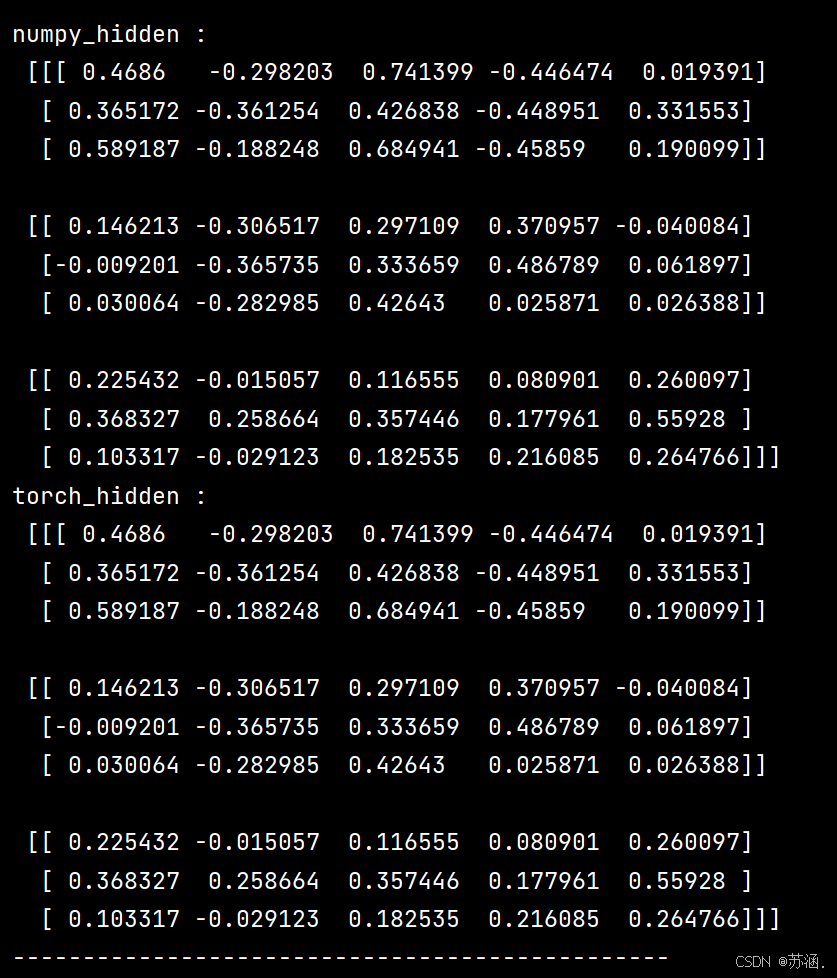
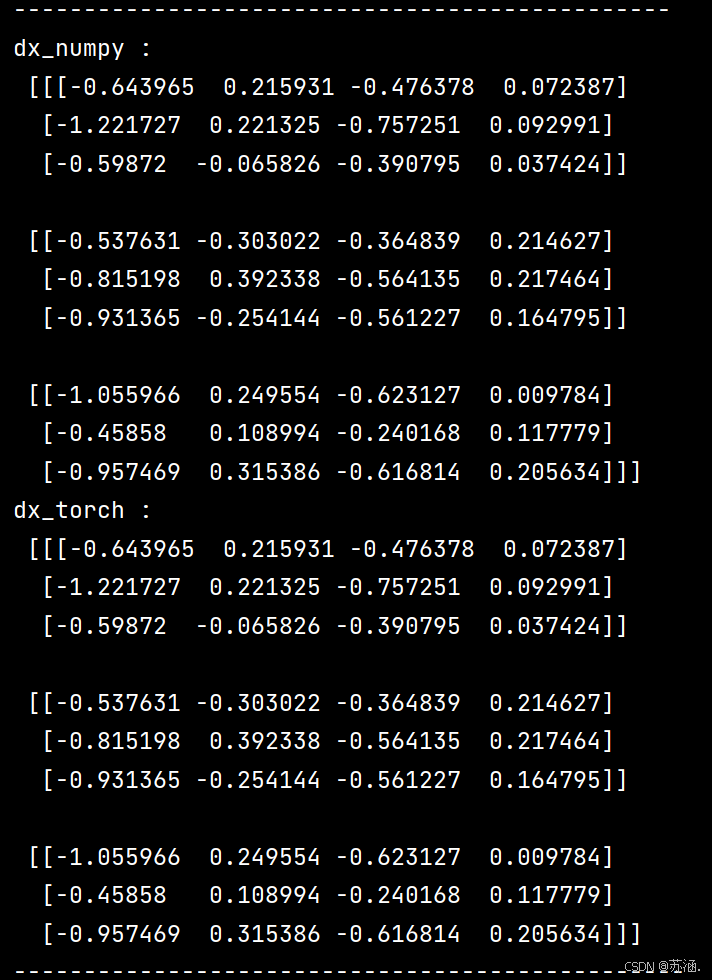
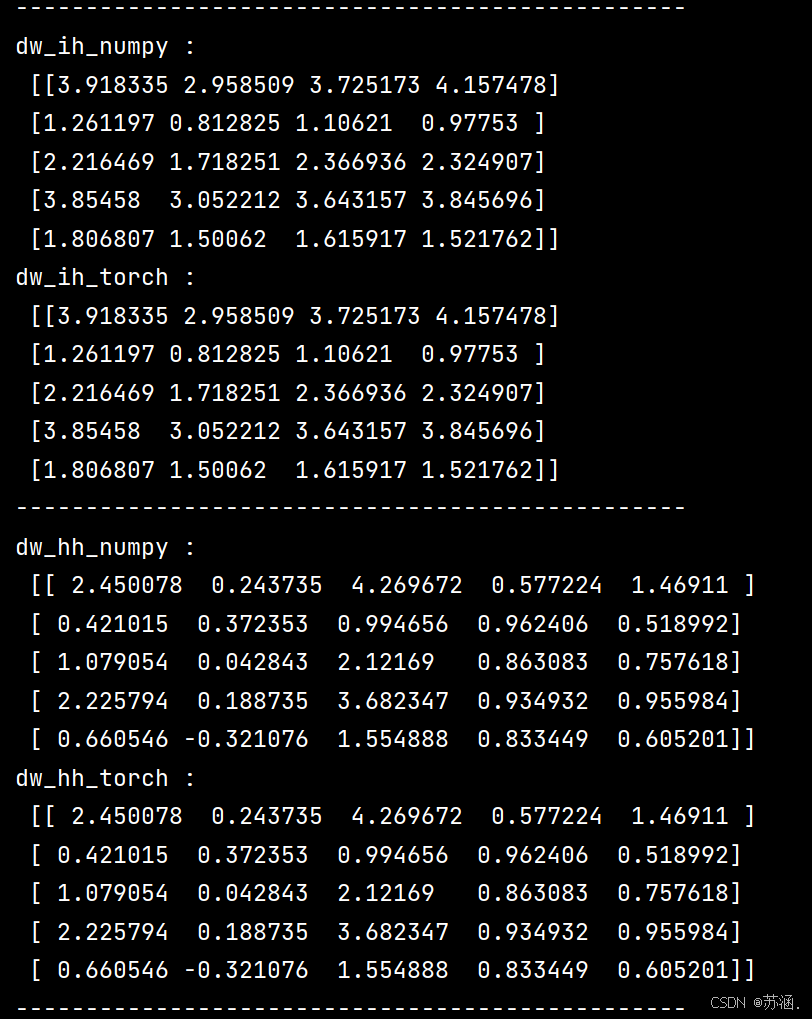
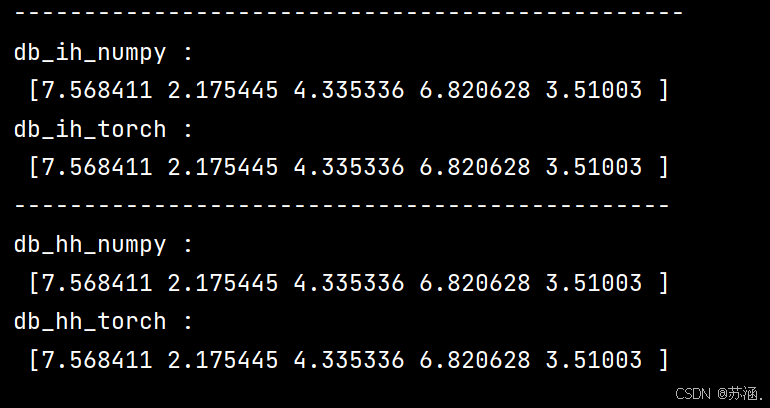
这次的分享就到这里,下次再见~
